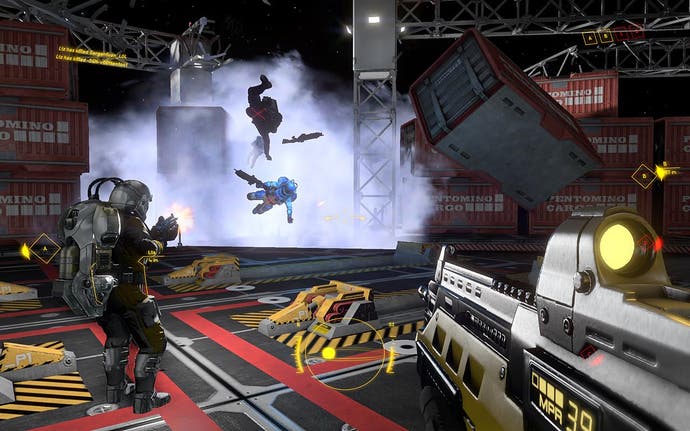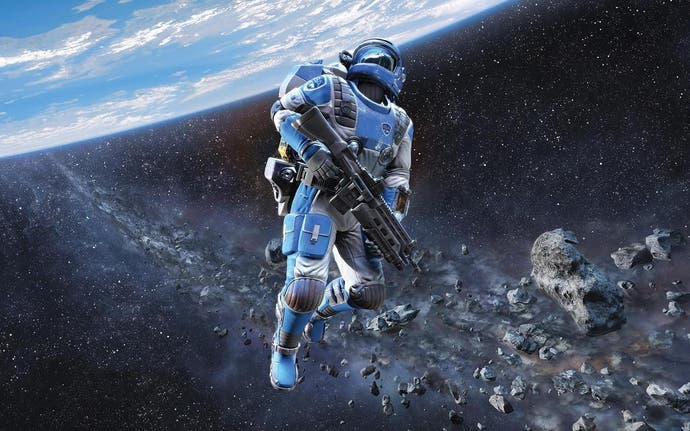Shattered Horizon: the FPS that got lost in space
Lament horizons.
We're going to have to change our ways at some point. Year after year we collectively moan about the lack of innovation in first-person shooters, and then, when a game does come along that dares to be different, we shoot holes in it for not being more like those we purport to hate, but actually can't get enough of. Hence the annual updates masquerading as franchise sequels, while the more daring and interesting shooters are overlooked and promptly forgotten about.
In the case of Shattered Horizon, however, we can be forgiven for our lack of appreciation. The outer space-based shooter from Futuremark - its debut game after more than a decade of making benchmarking software - didn't exactly receive the most effusive of praise upon its release in 2009, earning a 6/10 from Eurogamer's then-space junkie Jim Rossignol in a review that was entirely well-reasoned and fair.
For all the good stuff that the game provided - a detailed and compelling backstory, a innovative UI and controls, and brilliantly realised zero-g environments that rewarded the spatially aware - a notable lack of content was high up the list of criticisms. As it turns out, however, it's problems were by an order of magnitude more fundamental than just a lack of content. In aiming for the stars, Shattered Horizon was almost doomed to wander gaming's outer reaches from the moment it was conceived.
"Futuremark was, and still is, a small company," says marketing manager James Gallagher, suggesting that creating the amount of content expected of a mainstream shooter - story-driven content especially - was far beyond its means. "I'm not sure how many game ideas were discussed and debated, but I do know that the concept of a space-based shooter was the one that everyone got excited about. We felt that complete freedom of movement in zero-gravity, and fully three dimensional level design, had huge potential to provide new experiences not found in other FPS games."

Yet without the resources to develop its ideas sufficiently for the solo player component, and with the success of Left 4 Dead and Team Fortress 2 suggesting such efforts might even be unnecessary, it was decided that "a skill-driven, multiplayer FPS was the right way to go."
Despite its evolved control mechanics that cleverly combined modern FPS sensibilities with the inertia-based movement of the space-combat sim, and with many a tense online gunfight set around and within crumbling asteroids, meteor-pitted satellites and deserted mining outposts, Shattered Horizon was as thin a game as the atmosphere it simulated. The initial release featured just four maps, all of which had the potential to disorientate the player on account of the six degrees of freedom involved, and the need to anchor to a surface in order to sustain any kind of accuracy.
It took more than a few hours to get used to just one orientation, let alone master the lot. With no AI bots to help train the curious, no vehicles or classes to provide any meaningful sense of progression, and just a single weapon to master, it would have felt to some like the game's apparent complexity was a deliberate ploy to mask a black hole where various game modes, levels, weapons and other assorted content should have been instead.
"As we were a small team, we had to be careful not to over-design the game or pack it full of features," says Gallagher. "The one "do it all" gun that combined long and close range firing modes, a grenade launcher, and a melee attack into one weapon was a way of limiting the scope of the design, while staying true to the game's environment. The "one gun" design was probably the most divisive factor in the game. Competitive players absolutely loved how it made movement and awareness the key skills in the game, but casual players - and most reviewers - didn't embrace it as readily."
The real problem for Futuremark was that, instead of licensing a 3D engine from the likes of Epic, it had elected to develop its own. "We had to put considerable effort into engine development and tools coding, rather than working on game features and content," says Gallagher, suggesting that were the game being made today, it would almost certainly be powered by Unity or Unreal.

As bad a decision as it may have been in hindsight, there were a number of persuasive arguments for pressing ahead with its own 3D solution, the most obvious being that Futuremark's business was built upon its own ability to craft 3D benchmarking tools. With the company's 3DMark Vantage engine in development, it made sense to expand its toolset to cope with the rigours of game iteration, not least because it would make Shattered Horizon among the first games to make use of the capabilities of DirectX 10, a platform for which Vantage was being made to service.
It was a compelling development pitch for a company used to operating on the frontier of the PCs capabilities. "I think there was definitely a belief in the studio and an expectation from players that Shattered Horizon should push the limit," admits Gallagher. "We wanted to create something that PC gamers would be proud to show to their console-owning friends."
Unfortunately for everyone involved, DirectX 10's exclusivity to Windows Vista, and Shattered Horizon's exclusivity to DX10, was to prove disastrous. Reviled by gamers for its high system requirements and DRM-friendly measures, most were content to stick with XP rather than invest in Microsoft's new operating system, which meant game developers remained loyal to DirectX 9 as well. "There was nothing out there to give gamers a reason to upgrade", rues Gallagher. "Windows 7 came in October 2009, a month before we released our game. Windows 7 was a big improvement over Vista, and gamers were much more enthusiastic about DirectX 11, but it put us in a difficult position.
"We couldn't delay releasing the game for long, but according to the Steam Hardware Survey at the time, only 50% of players had PCs that were capable of running it. It was a major problem for a game based on pure online multiplayer. Our only option was to release it and hope that more gamers would upgrade. It wasn't until 2012 that major games started appearing that required DirectX 10 or higher. Sadly, that was too late for us."
For more than a year after its release, Futuremark worked to expand Shattered Horizon's slender content, first by doubling the number of maps, then expanding the player's arsenal, before introducing bots in early 2011. In titling what was to be Shattered Horizon's final update The Last Stand, however, it seemed as if Futuremark were ready to call time on the game's development, and shelve plans not only for a slew of features that might have benefited the game's still quietly active community, but put an end to dreams of a sequel.

Designs for a story-focused single-player game were pitched to publishers, with a playable demo ready by the middle of the year, but to no avail. "We got to a fairly advanced level of talks with a few well known publishers. We heard that some publishers see upward of 300 pitches a year, and go ahead with 3 at the most, so we were realistic about our chances. We took the rejections on the chin, listened to the feedback, improved our pitch and kept trying, again and again. Rovio was not one of the companies we pitched to, but when they made an offer for the studio in 2012, it was too good to pass up."
One can't help but wonder how Shattered Horizon, or the fortunes of Futuremark's game studio, might have fared had it been able to hold out a little longer and jump aboard the Kickstarter bandwagon, which by the time of Rovio's acquisition had driven the early successes of games like Broken Age, FTL, Wasteland 2 and Shadowrun, and within a few months was to literally kickstart virtual reality.
"Can you imagine playing Shattered Horizon in VR?" rues Gallagher, wistfully. "The games industry has changed so much in the last seven years. Who knows how things might have turned out if we'd had access to a free 3rd-party engine, to crowdfunding sites like Kickstarter, or early-access on Steam. Indie gaming is bigger now, eSports is bigger. Digital distribution is easier and more effective now.
"Looking back, six years later, the thing I'm most proud of is that Shattered Horizon is still a completely original game and concept. There's nothing else like it. Maybe someday, someone will have a go at making another zero-gravity shooter, but for now, Shattered Horizon still offers a unique experience, and a refreshing change from typical military shooters."
Alas, it's largely unavailable to play unless you already own it or are willing to buy a Steam key from the troubled Desura service. Last year Futuremark reasoned that it was no longer able to support its games when it was no longer in the business of making them. "And since there were some issues with leaderboards and stats, we decided the right thing to do was to take the game down from sale. It just felt wrong to take money for a game we weren't supporting."
